Serviços Personalizados
Artigo
Indicadores
Links relacionados
-
 Citado por Google
Citado por Google -
 Similares em Google
Similares em Google
Compartilhar
Water SA
versão On-line ISSN 1816-7950
versão impressa ISSN 0378-4738
Water SA vol.35 no.3 Pretoria Abr. 2009
Treatment of swine wastewater with subsurface-flow constructed wetlands in Yucatán, Mexico: influence of plant species and contact time
Fedro Tapia GonzálezI; Germán Gíacoman VallejosII; Jorge Herrera SilveiraI; Carlos Quintal FrancoII; Joan GarcíaIII; Jaume PuigagutIII, IV, V, *
IDepartamento de Recursos del Mar, CINVESTAV-IPN, Unidad Mérida, Carretera Antigua a Progreso km. 6, Mérida, Yucatán, C.P. 97310, México
IIFacultad de Ingeniería, UADY, Investigador Académico de Ingeniería Ambiental, Av. Industrias No Contaminantes por Anillo Periférico Norte, Mérida, Yucatán, Apdo. Postal 150, México
IIISecció d'Enginyeria Sanitària i Ambiental; Departament d'Enginyeria Hidràulica, Marítima i Ambiental; Universitat Politècnica de Catalunya; c/Jordi Girona 1-3, Modul D-1, 08034 Barcelona, Spain
IVDépartement CGM (des génies civil, géologique et des mines) École Polytechnique de Montréal Case postale 6079, succursale Centre-ville (2900 boul. Edouard-Montpetit) Montréal (Québec), Canada, H3C 3A7
VInstitut de Rércherche en Biologie Vététale (IRBV); 4101 Sherbrooke Est, Montréal (Quebec), Canada, QC H1X 2B2
ABSTRACT
This study evaluates the capability of horizontal subsurface-flow constructed wetlands (SSF CWs) for treating pretreated swine wastewater as a function of contact time (CT) and type of macrophyte under the local conditions of Yucatán, Mexico. Experiments were conducted from July 2004 to November 2005 on a swine-fattening farm. The study had three stages: first, macrophytes were located and collected; second, plants were acclimatised; and third, a pilot plant with 6 wetlands was set up, operated and evaluated. The effectiveness of the wetlands was intensively tested over 2 periods (April and November 2005). The results indicate that treatment efficiency significantly improved with increased CT for most of the analysed contaminants. The highest removal rates were recorded at a CT of 3 d and ranged between 64 and 78% for total suspended solids, 52 and 78% for COD, 57 and 74% for BOD5, 57 and 79% for total nitrogen, 63 and 75% for ammonium nitrogen, 70 and 81% for nitrate, 0 and 28% for total phosphorus and 3.3 and 4.2 log-units for total coliforms. Results also suggest that the macrophyte species used did not significantly differ on their contribution to overall treatment efficiency. However, vegetated beds slightly improved water quality when compared to unplanted systems. Horizontal SSF CWs are a suitable technology for treating swine wastewater under the local conditions of Yucatán. Contact time should be given special attention in the design of future full-scale facilities.
Keywords: reed beds, swine wastewater, contact time, plant species
Nomenclature
| SSFCW | subsurface-flow constructed wetlands |
| ST | septic tank |
| DS | drum screen |
| Ps | sedimentation pond |
| CT | contact time |
| CT 1 | contact time of one day |
| CT 2 | contact time of two days |
| CT 3 | contact time of three days |
| OLR | organic loading rate |
| HLR | hydraulic loading rate |
| TSS | total suspended solids |
| COD | chemical oxygen demand |
| BOD5 | biochemical oxygen demand |
| TN | total nitrogen |
| TP | total phosphorus |
| TCF | total coliforms |
Introduction
In Mexico, the pig-farming sector requires suitable and integrated technological solutions to control pollution caused by the pig-farming cycle, mainly for 2 reasons: first, the national and state environmental authorities have increased pressure on industrial activities in the form of fines, and second, the Mexican Government has announced that farmers who do not treat their animal waste properly would lose their certificates? licences? Author to check allowing them to export pork.
Mexico is the 2nd largest swine producer in Latin America (>18 million pigs in 2004) and the 18th largest worldwide. Almost 70% of Mexico's swine production is located in 6 states: Jalisco, Sonora, Guanajuato, Puebla, Michoacán and Yucatán (Franco, 2006). Yucatán's pig-farming registry for the year 2001 showed a pig population of about 1 750 000 (INEGI, 2005). Each pig generates around 36 ℓ·d-1 of pig waste (Taiganides et al., 1996) which leads to a total of approximately 63 000 m3·d-1. Nitrogen and phosphorus concentrations are generally very high in the raw waste, about 2 500 and 600 mg·ℓ-1, respectively (Costa et al., 2000). If these nutrient-rich wastes are applied to agricultural soil at a higher rate than crop uptake ability, soil fixation and processing, the excess nutrients may reach surface and groundwater due to runoff and leaching (Stone et al., 1998).
In Yucatán, pig farmers commonly dump the primary-treated swine waste directly onto agricultural land because there are no environmental regulations pertaining to the discharge of wastewater that infiltrates into the ground. In fact, the only environmental regulations on water quality in Mexico refer to surface water (NOM-001-ECOL-1996). The common practices of local farmers have therefore raised special concern in the region, since the widespread presence of karst soils facilitates a rapid percolation of contaminants from agricultural soil to aquifers. Groundwater contamination is of special concern in the region because aquifers are the main source of drinking water. In a study by Pérez and Pacheco (2004) conducted in 106 municipalities in the region, 21 municipalities were found to exceed the upper limit of 45 mg·ℓ-1NO3- in supply water. Therefore, despite the lack of environmental regulation on wastewater that infiltrates into the ground, it is clearly of capital interest – in both environmental and public-health terms – to reduce the nutrient load to the Yucatán environment. Alternative or additional swine-waste treatment systems need to be implemented in order to reduce the potential environmental and health problems related to swine waste.
Constructed wetlands are biological wastewater treatment systems in which contaminants are removed by means of various mechanisms such as sedimentation, filtration, microbial degradation and plant uptake (Ciria et al., 2005). They are normally used to treat settled effluent from rural housing, but are now being considered for treating farm-produced wastewater (McGechan et al., 2005). Constructed wetlands appear to be a suitable technology for treating swine wastewater in the Yucatán region since they can easily be managed by non-specialised staff and have low maintenance and operation costs (Reddy et al., 2001). Moreover, studies have shown that constructed wetlands have successfully treated animal wastewater in other regions (Payne et al., 1992; Hunt et al., 1994). The type of constructed wetland most commonly used to treat swine wastewater is the surface-flow constructed wetland (SF CW) (Hunt and Poach, 2001), but there have also been a few successful experiences with subsurface-flow systems (Kantawanichkul et al., 1999 and 2001; Lee et al. (2004); Sezerino et al., 2003). Little is known, however, about the suitability of SSF CWs for treating farm wastes with a high nitrogen load.
The main objective of this study, therefore, was to test the capability of horizontal SSF CWs for treating pretreated swine wastewater (under the local conditions of Yucatán) as a function of contact time (CT) and type of macrophyte.
Methods
Background to the experimental studies
Experiments were conducted over a period of 16 months (July 2004 to November 2005) on a swine-fattening farm located in the town of Conkal, in the north of Yucatán, southern Mexico. The farm's 3 000 animals produce about 90 m3·d-1 of wastewater. Different activities were carried out in each of the study's 3 stages. In the 1st stage, which lasted 1 month (July 2004), the macrophytes used for the experiments were located and collected. In the 2nd stage, which lasted 5 months (August-December 2004), the macrophytes were acclimatised. In the 3rd stage, which lasted 11 months (January-November 2005), 6 pilot horizontal SSF CWs were set up and operated. The macrophytes that had proved to be the most resistant during the acclimatisation period (Typha latifolia and Eleocharis interstincta) were used in the 3rd stage. During this final stage, the effectiveness of the wetlands was tested twice: Once in April 2005 in the dry season that lasts from March to June, when rainfall is less than 100 mm and temperatures are high (daily maximum temperatures of 36 to 40˚C); and then in November 2005, in the 'nortes' season that lasts from November to February, when rainfall is very low at less than 50 mm and temperatures are cool (daily maximum temperatures of 20 to 23˚C)
Location, collection and acclimatisation of macrophyte species
During the 1st stage of the study, emergent aquatic macrophytes growing in the natural ecosystems of Yucatán were collected and cultivated. The purpose was to select those species which were best adapted to growing under the severe conditions created by swine wastewater. A total of 5 species (Fimbristylis spadicea, Typha latifolia, Eleocharis interstincta, Arundinella berteroniana and Cladium jamaicensis) were collected and cultivated in 5 plastic tanks (length 1.1 m, width 0.7 m and depth 0.6 m). Each plastic tank was filled to a height of 0.3 m with gravel (diameter 10 to 30 mm), followed by an 0.15 m thick top layer of sand, to simulate the conditions in which macrophytes would grow in horizontal wetlands. These tanks were fed with 50 ℓ of pretreated swine wastewater each day throughout the 5 months of the 2nd stage.
Physico-chemical characterisation of swine wastewater
On the farm, the wastewater generated during the fattening cycle is discharged to a septic tank (ST), from which it is pumped to a drum screen (DS) before being diverted to the receiving environment. Solids derived from this treatment are disposed of on agricultural lands without additional treatment. In this study, 3 m3 of the DS effluent were transferred every day to 3 parallel pilot sedimentation ponds (Ps). From there, the wastewater was pumped to a storage tank that fed the horizontal wetlands (Fig. 1). As additional treatment, sedimentation ponds were used to remove solids, thereby reducing the organic loading rate (OLR) applied to the wetlands. The physico-chemical properties of the Ps effluents were analysed in April 2005. A total of 12 samples were collected on 4 consecutive days from each pretreatment effluent, prior to the first wetland sampling campaign. The physico-chemical parameters analysed were pH, total suspended solids (TSS), chemical oxygen demand (COD), biochemical oxygen demand (BOD5), total nitrogen (TN), ammonium nitrogen (NH4+-N), nitrate nitrogen (NO3--N), total phosphorus (TP) and total coliforms (TCF). All of these parameters were analysed according to Standard Methods (2001) and are summarised in Table 1. NH4+-N was analysed by means of a prior distillation step in the Kjeldahl method.
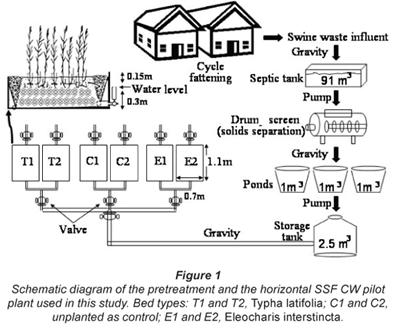
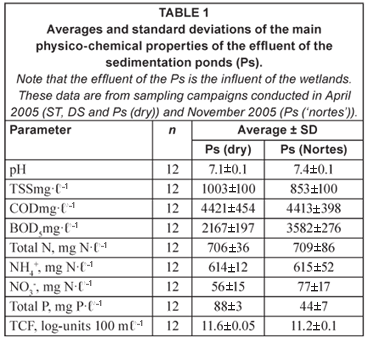
Horizontal SSF CWs
The pilot plant was fed with pretreated wastewater from the Ps (i.e. wastewater that had been stored in a tank). The plant consisted of 6 identical parallel beds (wetlands), of which 2 were planted in February 2005 with Typha latifolia (T), 2 were planted with Eleocharis interstincta (E), and 2 remained unplanted as controls (C). Plants were established at a density of 15 shoots.m-2 and allowed to grow to densities of approximately 65 shoots·m-2 at the start of the experiment. These 2 species were selected from among all of the cultivated macrophytes because they had the best appearance and development during the acclimatisation period. Each system consisted of 6 identical beds made of PVC with length, width and depth of 1.1 m, 0.7 m and 0.45 m respectively. Furthermore, each bed was filled to a height of 0.3 m with gravel with a diameter ranging from 10 to 30 mm (D10= 32 mm), followed by a 0.15 m thick top layer of sand (D10= 2 mm). The initial porosity was 40% and 32% for the gravel and sand media, respectively. The nominal pore space of each bed was 50 ℓ (experimentally measured at the beginning of the sampling period). During the experimental phase the water level in each bed was kept constant at about 0.05 m below the surface of the sand.
Wetlands monitoring and data analysis
The performance of the wetlands was monitored over 2 periods, in the dry and "nortes" seasons, over 9 consecutive days of intensive sampling of the effluent of each bed. Note that, although the sampling was conducted in a short period of time, fixed biomass reactors (as the constructed wetlands) are generally less affected by changes in environmental and/or operational conditions (Brix and Schierup, 1989). On the other hand, in order to evaluate the effect of CT on treatment efficiency, the systems were operated at three different CTs for these 9 d. For the testing of each different CT pretreated wastewater was supplied in quantities of 50 ℓ depending on the desired contact time, with excess water being displaced from the toe of the bed. Specifically, contact times were 1 d (CT1), 2 d (CT2) and 3 d (CT3). For each contact time water was removed from the toe of the bed at 4 h intervals over a period of 12 h during the day of sampling and the samples were mixed to obtain a composite sample. Thus for CT1, water was removed after 24, 28, 32 and 36 h, for CT2 it was removed after 48, 52, 56 and 60 h, and for CT3 it was removed after 72, 76, 80 and 84 h. Following each experimental run, the water in the bed was removed and replaced with fresh pretreated wastewater. After runs of CT1, CT2 and CT3, another 3 d experimental run was undertaken, and samples were taken as for CT1, CT2 and CT3 without replacing the water each time. Table 2 summarises the operational conditions of each wetland by CT.
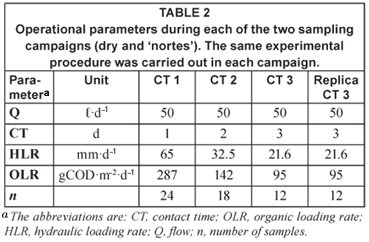
Statistical analyses were carried out using the Statgraphics Plus 4.1 statistical software package. One- and two-way ANOVA methods were used to check the influence of each factor considered (presence/absence of macrophytes and CT) for each water-quality parameter and to evaluate the interactions between factors. For each ANOVA test, it was checked whether the variables were normally distributed; if not, they were log-transformed. To discriminate among the means, Fisher's least significant difference (LSD) procedure was used.
Results and discussion
Organic matter and TSS removal in the wetlands
In our study, effluent TSS, COD and BOD5 concentrations clearly decreased as the CT increased in all cases tested. Planted wetlands produced effluents whose quality was 5 to 15% better than those of the unplanted controls (Tables 3 and 4). In general terms, the organic matter removal results suggest that CT influences wetlands performance more than the type of macrophyte.
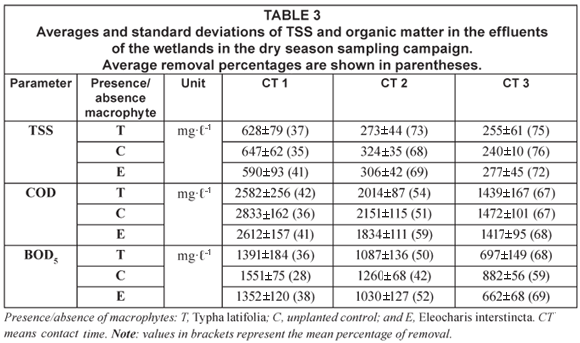
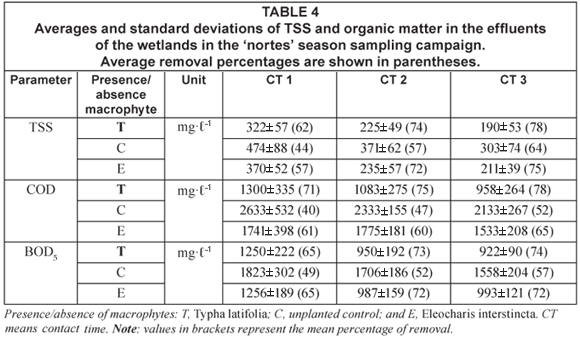
TSS removal efficiencies ranged from 35 to 76% in the dry season and from 44 to 78% in the "nortes" season. The organic matter removal results showed a pattern similar to that of TSS. Specifically, in the dry season, efficiencies ranged from 36 to 68% and from 28 to 69% for COD and BOD5, respectively; in the "nortes" season, they ranged from 40 to 78% and from 49 to 74% for COD and BOD5, respectively. The literature on this topic reports a wide range of TSS and organic matter removal efficiencies in constructed wetlands treating swine wastewater, as discussed below.
Kantawanichkul et al. (2001) reported a COD removal efficiency of 98% in a pilot combined wetland system (a vertical SSF CW followed by a horizontal SSF CW) treating raw swine waste and operated with an OLR of 105 g COD m-2·d-1 and a hydraulic loading rate (HLR) of 37 mm·d-1. Sezerino et al. (2003) observed lower COD removal efficiencies, ranging from 25 to 54%, for a vertical SSF CW treating swine waste and operated with an OLR ranging from 12 to 23 g COD m-2·d-1 and an HLR of 30 mm·d-1. Lee et al. (2004) reported removal efficiencies of 99% for TSS, 77% for COD and 86% for BOD5 for a horizontal subsurface SSF CW fed with pretreated swine waste and operated with an OLR of 130 g COD m-2·d-1 and a HLR of 120 mm·d-1. In our study, we found that the highest removal efficiencies of TSS and organic matter (COD and BOD5) were observed for CT 3 when the OLR was 95 g COD m-2·d-1 and the HLR was 21.6 mm·d-1; in this case, the removal efficiencies ranged from 64 to 78% for TSS, 52 to 78% for COD and 57 to 74% for BOD5. The organic matter and TSS removal efficiencies observed in our study were therefore generally lower than those reported by Lee et al. (2004) and Kantawanichkul et al. (2001) and higher than those reported by Sezerino et al. (2003). The wide range of efficiencies in TSS and organic matter removal found in different studies is probably related to the great variation of pig-waste composition, which is, in turn, highly dependent on farm management and storage conditions (Boursier et al., 2005).
According to our statistical analysis, CT caused significant statistical differences in the average effluent concentration of TSS, COD and BOD5 in all bed types (i.e. with or without macrophytes) and in both campaigns (Table 5). The test used to discriminate among the means indicated that all pairs of means were different for BOD5 and COD. For TSS, most of the differences were between CT 1 and the 2 other CTs.
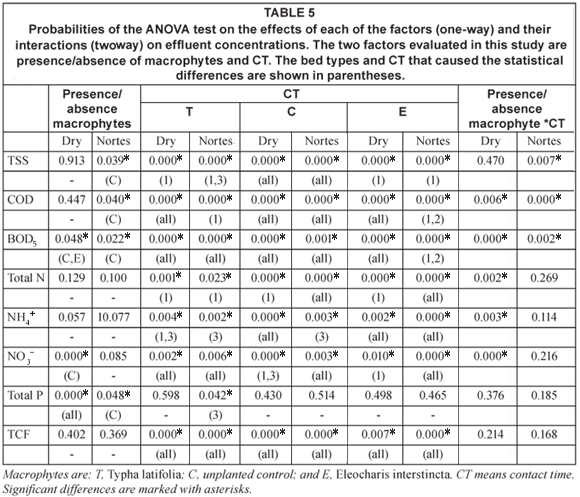
The ANOVA test revealed significant interactions between the two factors (presence/absence of macrophytes and CT) for TSS in the "nortes" season and for COD and BOD5 in both campaigns. These interactions were due to the fact that effluent concentrations were clearly lower in CT 3 than in CT 1 and CT 2, and that the planted beds had lower concentrations than the unplanted beds.
Nutrient removal in the wetlands
The effluent TN and NH4+ concentrations clearly decreased as CT increased, regardless of the type of macrophyte (Tables 6 and 7). These results contrast with those found for ammonium in the study of Lee et al. (2004), who observed that the lowest removal rates occurred at the greatest hydraulic retention time. The planted wetlands generally produced effluents whose quality was between 2 and 5% better than that of the unplanted beds for TN and NH4+ (Tables 6 and 7). In the case of NO3-, there was no clear relationship between effluent concentration and CT, since during the dry season the lowest concentrations were observed for CT 2, whereas in the "nortes" season the results varied with the type of treatment.
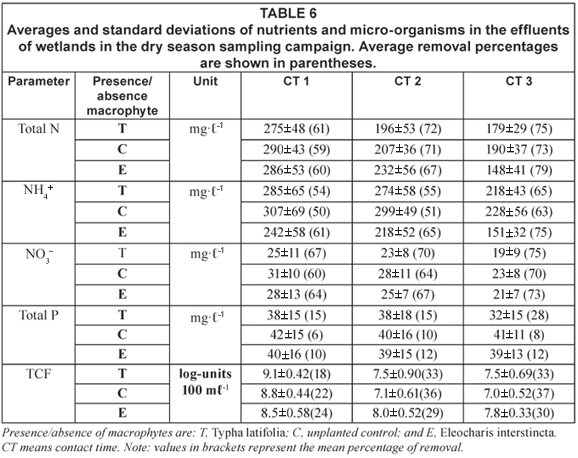
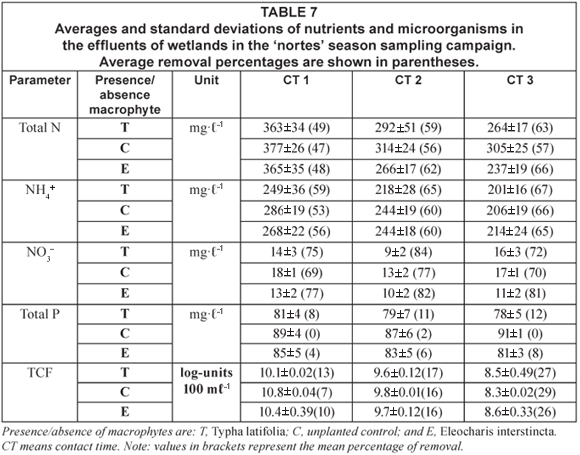
The TN removal efficiencies ranged from 47 to 66% in the dry season and from 59 to 79% in the "nortes" season, whereas the NH4+ removal efficiencies ranged from 53 to 67% in the dry season and from 50 to 75% in the "nortes" season. The NO3- removal efficiencies ranged from 69 to 84% in the dry season and from 60 to 75% in the 'nortes' season. The planted beds had the best NO3- removal performance (Tables 6 and 7, next page).
The literature generally reports lower nitrogen removal efficiencies than those found in this study. For example, Lee et al. (2004) reported removal efficiencies for TN, NH4+ and NO3- ranging from 1 to 22%. The higher efficiencies observed in our study may be linked to our intermittent feeding strategy. Intermittent feeding may have enhanced re-aeration of the granular medium, which in turn would have increased biochemical aerobic routes. In fact, the removal efficiencies observed in this study are very similar to those reported for vertical SSF CWs by Sezerino et al. (2003) (2 to 68%) and by Kantawanichkul et al. (1999) (80 to 90%). The rather high removal rates observed in the experiments of Kantawanichkul et al. (1999) may be related to the fact that the authors used diluted swine wastewater.
Based on statistical analyses conducted on nitrogen species, we can conclude that CT caused significant statistical differences in terms of the average effluent concentrations of TN, NH4+ and NO3- in all treatments in both campaigns (Table 5). The test used to discriminate among the means indicated that all of the pairs of means were statistically different for the three nitrogen species. The greatest average differences were observed between CT 1 and CT 3 regardless of the type of macrophyte.
The ANOVA test revealed significant interactions between the 2 factors (presence/absence of macrophytes and CT) for TN, NH4+ and NO3- in the dry season campaign. These interactions were due to the fact that the planted beds had significantly lower concentrations than the unplanted beds during the dry season.
The TP removal efficiencies were generally lower than those of the other contaminants. TP removal ranged from 0 to 12% in the dry season and from 6 to 28% in the 'nortes' season (Tables 6 and 7). According to the statistical tests, CT seemed not to have a significant effect on TP removal (Table 5). On the contrary, as has been previously described by Vymazal (2003), the presence of macrophytes had a significant effect on the performance of the systems. The TP removal efficiencies obtained in this study were, however, lower than those reported by Lee et al. (2004) (47 to 59%).
Microbial removal in the wetlands
The TCF removal was generally not high enough to produce effluents with low concentrations. Effluent TFC concentrations ranged from 10.8 to 10.1 log-units·100 mℓ-11 in the dry season and from 9.1 to 8.5 log-units·100 mℓ-1in the 'nortes' season for CT 1, from 9.8 to 9.6 log-units·100 mℓ-1 in the dry season and from 8.0 to 7.1 log-units·100 mℓ-1in the 'nortes' season for CT 2, and from 8.6 to 8.3 log-units·100 mℓ-1in the dry season and from 7.8 to 7.0 log-units·100 mℓ-1in the 'nortes' season for CT 3. Removal efficiencies ranged from 3.3 log-units in the dry season to 4.2 log-units in the 'nortes' season. These removal efficiencies agree with those reported by Kantawanichkul et al. (1999) (approximately 4 log-units). The ANOVA test indicated that there were no statistical differences in the average effluent TFC values between the various types of beds within the same CT (Table 5). On the contrary, CT caused significant differences in TFC concentrations. The test used to discriminate among the means indicated that all pairs of means were different.
Summary of all results
CT caused clear differences in removal efficiency for most of the evaluated contaminants. Therefore, it may be considered as a key parameter in the performance of horizontal SSF CWs treating swine wastewater. In contrast, the differences between planted and unplanted systems were not clear or were very low, especially in the dry season. This contrasts with the studies of Brison et al. (2006) and Ciria et al. (2005), which reported a clear contribution by plants on contaminants removal. It is likely that the high concentrations of contaminants treated in this study masked the macrophytes' contribution to overall treatment efficiency (Brix, 1997). Only in the case of BOD5 planted wetlands clearly showed superior treatment efficiency, with removal efficiencies of 68% in planted wetlands (Typha latifolia) and 59% in unplanted beds for both periods.
The wetlands had slightly better removal efficiencies in the 'nortes' campaign than in the dry campaign. Specifically, during the 'nortes' season, the wetlands had 2 to 10%, 4 to 10%, 6 to 21%, 13 to 14% and 3 to 8% higher removal efficiency for TSS, COD, BOD5, TN and NH4+-N, respectively. This trend seems to be linked to the higher evapotranspiration rates in the dry season, which would increase the contaminant concentrations in the wetlands. Unfortunately, evapotranspiration was not directly quantified at the time of the experiments; in the dry season, however, temperatures and wind speed are higher and humidity is lower, so we may reasonably assume that the evapotranspiration rates would have been higher. It is common for treatment efficiency in many constructed wetlands to decrease in dry periods due to high rates of evapotranspiration (Kadlec and Knight, 1996).
Care should be taken when applying the results of this study, since they were obtained from small pilot wetlands and during a short evaluation period. Nevertheless, these results provide a starting point for the use of horizontal SSF CWs in Yucatán and gives insight of the potential application of this technology for an environmental concern in the region.
Conclusions
The results of this study clearly indicate that CT is a key factor in the removal of a wide variety of contaminants (COD, BOD5, TN, NH4+, NO3- and micro-organisms) in horizontal SSF CWs treating swine wastewater.
According to the results of this study Typha latifolia and Eleocharis interstincta are the most suitable macrophyte species to be used for the treatment of piggery wastewater under Yucatan's local conditions. In spite of the fact that high contaminant concentrations in wastewater may have masked the macrophytes' contribution to the overall treatment efficiency, vegetated beds usually provide better effluent quality than unplanted beds.
The best contaminant removal efficiencies were for a CT of 3 d. In such conditions, removal efficiencies ranged between 64 and 78% for TSS, between 52 and 78% for COD, between 57 and 74% for BOD5, between 57 and 79% for TN, between 63 and 75% for NH4+, between 70 and 81% for NO3-, from 0 to 28% for TP and between 3.3 and 4.2 log-units for TCF.
In general terms, the results of this study suggest that horizontal SSF CWs could be a suitable technology for treating swine wastewater in Yucatán. Furthermore, CT clearly deserves special attention in the future design of full-scale facilities.
Acknowledgements
This work forms part of the Ph.D. thesis of Fedro Tapia at the Mérida Unit of CINVESTAV-IPN and the Engineering School of UADY. We acknowledge Javier Ramírez, José Ramírez, Roberto Pat, Javier Frías, Víctor Coronado and Olga Briceño for their assistance with sample collection and physico-chemical analysis, and for their experience in the study area. We also thank CONACyT and Fondos Mixtos Campeche.
References
BOURSIER H, BÉLINE F and PAUL E (2005) Piggery wastewater characterisation for biological nitrogen removal process design. Bioresour. Technol. (96) 351-358. [ Links ]
BRISSON J, CHAZARENC F and BISAILLON L (2006) Maximizing pollutant removal in subsurface constructed wetlands: should we pay more attention to macrophyte species selection? Proc. 10th Int. Conf. on Wetland System for Water Pollution Control. Volume II, 909-917. [ Links ]
BRIX H (1997) Do macrophytes play a role in constructed treatment wetlands? Water Sci. Technol. 35 (5) 11-17. [ Links ]
BRIX H and SCHIERUP H (1989) The use of macrophytes in water pollution control. Ambio 18 100. [ Links ]
CIRIA MP, SOLANO ML and SORIANOP (2005) Role of macrophyte Typha latifolia in a constructed wetland for wastewater treatment and assessment of its potential as a biomass fuel. Biosyst. Eng. 92 (4) 535-544. [ Links ]
COSTA RHR and MEDRI W (2000) High-rate pond for treatment of piggery wastes. Water Sci. Technol. 42 (10-11) 357-362. [ Links ]
FRANCO M (2006) Methane to markets: Mexico program overview. Technical Report by PA Consulting Group, Mexico. [ Links ]
HERRERA-SILVEIRA JA (1994) Spatial heterogeneity and seasonal patterns in a tropical coastal lagoon. J. Coastal Resour. 10 (3) 738-746. [ Links ]
HUNT P G and POACH M E (2001) State of the art for animal wastewater treatment in constructed wetlands. Water Sci. Technol. 44 19-25. [ Links ]
HUNT PG, HUMENIK FJ, SZOGI AA, RICE JM, STONE KC and SADLER EJ (1994) Swine wastewater treatment in constructed wetlands. In: Proc. of the 2nd Conference on Environmentally Sound Agriculture, University of Florida. 268-275. [ Links ]
INEGI (2005) Instituto Nacional de Estadistica, Geografía e Informática. El sector alimentario en México. 314 pp. [ Links ]
KADLEC RH and KNIGHT RL (1996) Treatment Wetlands. Lewis, CRC Press. Boca Raton, Fl., USA. 893 pp. [ Links ]
KANTAWANICHKUL S and NEAMKAM P (2001) Nitrogen removal in a combined system: vertical vegetated bed over horizontal flow sand bed. Water Sci. Technol. 44 (11-12) 137-142. [ Links ]
KANTAWANICHKUL S and PILAILA S (1999) Wastewater treatment by tropical plants in vertical-flow constructed wetlands. Water Sci. Technol. 40 (3) 173-178. [ Links ]
LEE C-Y, LEE C-C, LEE F-Y, TSENG S-K and LIAO C-J (2004) Performance of subsurface flow constructed wetland taking pretreated swine effluent under heavy loads. Bioresour. Technol. 92 173-179. [ Links ]
McGECHAN MB, MOIR SE, SYM G and CASTLE K (2005) Estimating inorganic and organic nitrogen transformation rates in a model of a constructed wetland purification system for dilute farm effluents. Biosyst. Eng. 91 (1) 61-75. [ Links ]
McGECHAN MB, MOIR SE, CASTLE K and SMIT IP (2005) Modelling oxygen transport in a reedbed-constructed wetland purification system for dilute effluents. Biosyst. Eng. 91 (2) 191-200. [ Links ]
PAYNE VWE, McCASKY TA and EASON JT (1992) Constructed wetlands for treating swine lagoon effluent. Proc. ASAE. 32 pp. [ Links ]
PÉREZ CR and PACHECO AJ (2004) Vulnerabilidad del agua subterránea a la contaminación de nitratos en el estado de Yucatán. Ingeniería 8 (1) 33-42. [ Links ]
REDDY G B and HUNT P G (2001) Treatment of swine wastewater in marsh-pond-marsh constructed wetlands. Water Sci. Technol. 44 545-550. [ Links ]
SEZERINO PH and REGINATTO V (2003) Nutrient removal from piggery effluent using vertical flow constructed wetlands in southern Brazil. Water Sci. Technol. 2 129-135. [ Links ]
STANDARD METHODS (2001) Standard Methods for the Examination of Water and Wastewater (20th edn.). APHA-AWWA-WEF American Public Health Association, Washington DC. [ Links ]
STONE KC and HUNT PG (1998) Impact of swine waste application on ground and stream water quality in an eastern coastal plain watershed. Trans. ASAE 40 (6) 1665-1670. [ Links ]
TAIGANIDES PE, PÉREZ R and GIRÓN E (1996) Manual para el manejo y control de aguas residuales y excretas porcinas en México. Instituto de Investigaciones Económicas. UNAM. Mexico. [ Links ]
VYMAZAL J (2003) Removal mechanisms in constructed wetlands. In: Dias V and Vymazal J (eds.) The Use of Aquatic Macrophytes for Wastewater Treatment in Constructed Wetlands. Articles of the 1st International Seminar. May 8-10, Lisbon, Portugal. Fundação Calouste Gulbenkian, Lisbon. 219-264. [ Links ]
Received 20 October 2008; accepted in revised form 22 January 2009.
* To whom all correspondence should be addressed.
+00 514 872 84 89; fax: +00 1 514 872 94 06;
e-mail: jaume.puigagut.juarez@umontreal.ca














